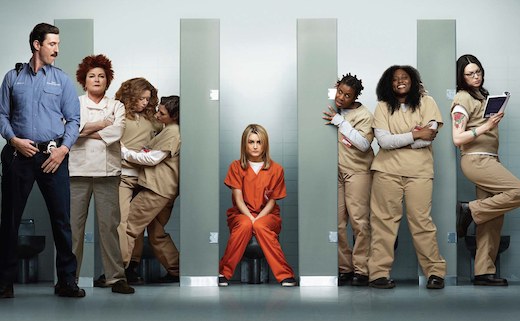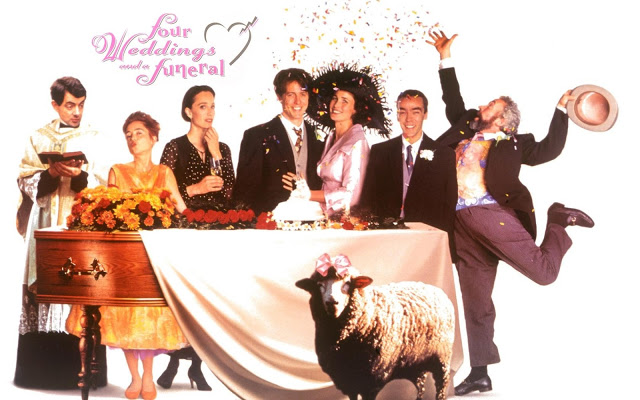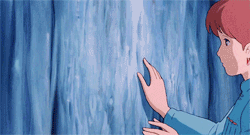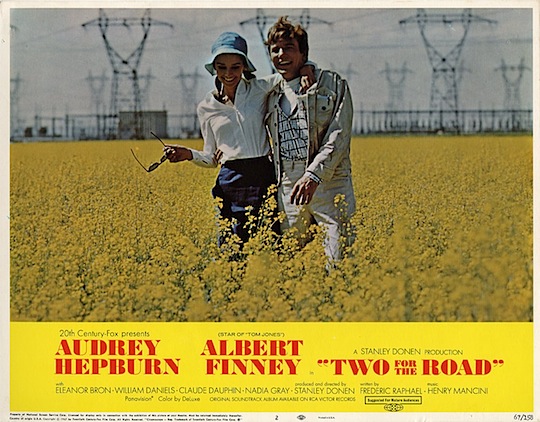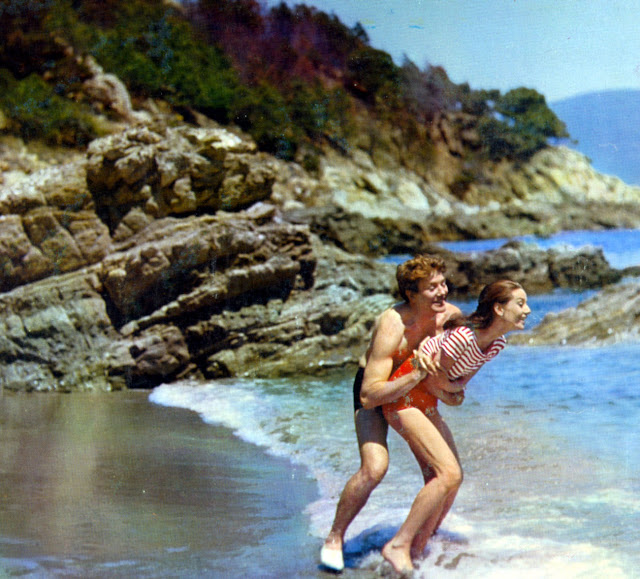This repost by Myrna Waldron appears as part of our theme week on Children’s Television.
 |
| Title screen for Adventure Time |
Warning: Spoilers up to the end of Season 3
Adventure Time is a Cartoon Network animated series that combines surrealistic comedy, fantasy and science-fiction. Based on a 2008 short by Pendleton Ward that went viral, it parodies the tropes, archetypes and cliches of fairy tales, video games and childhood action figure battles. The basic premise is about Finn, the last remaining human, and his best friend/adoptive brother Jake (a shape-shifting dog), going on your typical slay-the-monster-save-the-princess adventures. Now in its fourth season, it’s an enormous hit with all genders and age groups and shows no signs of slowing down. And let me tell you, as a feminist, why I am absolutely celebrating this show.
 |
| The main cast of Adventure Time |
- Almost every female character is a princess, but the typical cliche Damsel In Distress and/or romance-obsessed girly-girl are parodied and subverted for all they’re worth. In several instances, the princess characters (Bubblegum especially) show little interest in romance, and far more interest in their own personal hobbies. Even more encouraging is that often the female characters are completely able to rescue themselves, and don’t need Finn and Jake’s help.
- The characters are given genuine honest-to-goodness flaws. Finn is heroic, but has a terrible bad temper and an impulsive streak. Jake is easygoing, but not nearly as clever or level-headed as he thinks he is. Princess Bubblegum is a scientific genius, but can be incredibly callous about the feelings of others. Marceline is a talented musician, but also has deep insecurities about how her friends perceive her. Flame Princess is astoundingly powerful, but also has dangerously passionate emotions. In all of these cases, there’s no black and white morality. It’s an important lesson for children (since this is a children’s show) to present morality as it really is – in shades of grey.
- I love all the female characters, including the gender flipped versions of Finn and Jake, Fionna and Cake. My main complaint with the series is that the female characters don’t appear nearly often enough, and especially not together. We eventually do get some Bechdel Test passing goodness (Bubblegum and Marceline don’t get along too well – and people have naturally interpreted this as sexual tension) but so far the three main female characters have not yet all appeared in the same story together. I suspect that the main reason for this is because each story is about 11-12 minutes in total, and there’s only so much time for introducing characters and conflicts.
 |
| Jake stretching around the other main cast members |
- Speaking of Fionna and Cake, I can see now why that episode is so astoundingly popular amongst the fandom. It’s easily my favourite one of the series. Fionna is an absolutely adorable character – slightly chubby instead of unrealistically slender, tomboyish instead of traditionally feminine, and she still retains her male counterpart’s bravery and heroicism. She still fights with a sword. For my fellow gamers, think of all the games you’ve played in which a female character is a sword fighter. Not very many, right? But there’s no reason they can’t, and this is one thing I really love about the gender flip episode. I also practically exploded with joy at the final scene where Fionna talks about how she has lots of guy friends, but isn’t interested in/isn’t ready to date them, and that there’s nothing wrong with that. THANK YOU. It’s incredibly frustrating how many people think that somehow something is missing if you don’t have an official romantic partner, or that men and women can’t have a platonic friendship. Shippers could do well to remember this – you can like someone without wanting to bang them. (Also, as a Sailor Moon fan, you can’t imagine my joy at seeing Fionna’s ballgown homage to Princess Serenity’s outfit) At any rate, I hope the Gender Swap episodes happen on a regular basis, rather than a once-a-season deal. Wouldn’t it be nice if we had more shows about an ass-kicking girl and her feline best friend? (*coughcoughSailorMooncoughcough*)
- This is a fairly obvious point, but I really love how Princess Bubblegum’s interest in science is depicted. She’s an absolute genius – shattering the still pervasive stereotype that the sciences are the domain of men – and she also bucks the stereotype that nerdy/geeky people are unable to have fun or to relate to others. Similarly, Marceline’s interest in punk/indie rock also combats the stereotype that rock is a genre made by and for the enjoyment of men. Girls like to headbang too!
- The Christmas special, which reveals that pseudo-antagonist Ice King was actually a human antique dealer driven insane by his find of a magic crown, is an interesting way of approaching and explaining his very archetypal tendency to kidnap and try to marry princesses. In the Ice King’s case, it’s not so much a wanting to stick to traditional fairy tale gender roles, but a manifestation of his grief over losing the fiance he used to nickname “Princess.” The Ice King is primarily a comic character, but this episode finally established him as being tragic.
 |
| Fionna and Cake |
- I appreciated that, for once, romantic tensions are resolved rather than dragged on, and on, and on, and on. They make it clear that while Princess Bubblegum likes Finn as a person, she feels she’s too old for him, and her sometimes callous treatment of his feelings proves that she isn’t the right partner for him. Flame Princess isn’t the perfect girlfriend either, but at least in their case, Finn and Flame got together very quickly, changing the romantic plotline from “Will they or won’t they?” to “What happens now they’ve got together?” I also like that Jake and Lady Rainicorn’s relationship is loving, positive, literally interracial, and well…adult. (Lady Rainicorn’s dialogue is only in Korean, and bilingual viewers have revealed she says some incredibly raunchy things that only Jake can understand)
- In the “Memory of a Memory” episode, Marceline’s (ex) boyfriend tries to bully her into traditional gender roles. He even pulls the “Go back in the kitchen and make me a sandwich” bit. She finds out he tried to trick her, and kicks his ass. (Also, dear men who think this joke is funny: Wow. You’re original. YES I AM GOING TO GO IN THE KITCHEN AND I’M GOING TO MAKE LOTS OF DELICIOUS FOOD WHICH YOU CAN’T HAVE.)
- In some ways, other than Marceline, Lumpy Space Princess is my favourite character. She is absolutely hilarious as a sassy valley girl type who, by most accounts, should not be as confident about her body and her sexiness as she “should” be. After all, she’s literally a purple ball of lumps. But this is an important message – you DON’T have to match cultural standards of beauty to be sexy. It’s all about confidence. I’m a fatass, and I’m friggin’ sexy if I do say so myself. And in her own way, LSP is sexy too. At least to fellow Space Lumps.
 |
| Finn |
- The show just keeps getting better every season. The quality of animation has spiked, the character arcs are realistic and well-defined, and the storylines are mature without losing their comedic edge. I’m absolutely hooked on this series, and it’s a refreshing feeling that this year, along with Gravity Falls, I got to watch some great new children’s shows that deserve every bit of praise they receive.
- Lastly, I love the sense of humour in the show. I’ve always been a fan of surrealism, as well as referential humour. And I’m also a big fan of fart jokes, like the one where Jake morphs himself into a farting cheetah. I’m 25 years old, and fart jokes are still funny.
Myrna Waldron is a feminist writer/blogger with a particular emphasis on all things nerdy. She lives in Toronto and has studied English and Film at York University. Myrna has a particular interest in the animation medium, having written extensively on American, Canadian and Japanese animation. She also has a passion for Sci-Fi & Fantasy literature, pop culture literature such as cartoons/comics, and the gaming subculture. She maintains a personal collection of blog posts, rants, essays and musings at The Soapboxing Geek, and tweets with reckless pottymouthed abandon at @SoapboxingGeek.
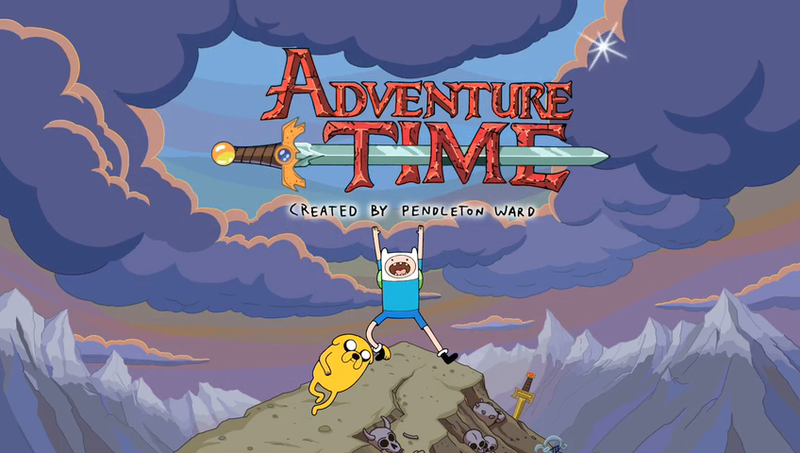


 Sailor Moon/Usagi Tsukino:
Sailor Moon/Usagi Tsukino: Sailor Mercury/Ami Mizuno:
Sailor Mercury/Ami Mizuno: Sailor Mars/Rei Hino:
Sailor Mars/Rei Hino:
 Sailor Venus/Minako Aino:
Sailor Venus/Minako Aino: Sailor Chibi-Moon/Chibiusa Tsukino:
Sailor Chibi-Moon/Chibiusa Tsukino: Sailor Pluto/Setsuna Meioh:
Sailor Pluto/Setsuna Meioh: Sailor Uranus/Haruka Tenoh:
Sailor Uranus/Haruka Tenoh: Sailor Neptune/Michiru Kaioh:
Sailor Neptune/Michiru Kaioh:





